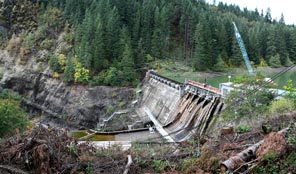forum
library
tutorial
contact

Another Dam Bites the Dust
by Editorial BoardThe Register-Guard, October 25, 2011
|
the film forum library tutorial contact |

|
Another Dam Bites the Dustby Editorial BoardThe Register-Guard, October 25, 2011 |
The blast will restore the White Salmon's natural flow
(Watch breach at National Geographic website)
 On Wednesday, contractors will use 700 pounds of dynamite to blow a hole in Condit Dam, draining the reservoir above it in six hours and restoring the White Salmon River to its natural flow for the first time in a century.
On Wednesday, contractors will use 700 pounds of dynamite to blow a hole in Condit Dam, draining the reservoir above it in six hours and restoring the White Salmon River to its natural flow for the first time in a century.
Condit won't be the first dam to be breached in the Northwest -- and it won't be the last. The Marmot Dam on the Sandy River and Gold Hill, Savage Rapids and Gold Ray dams on the Rogue River all have been removed. The demolition of two dams on the Elwha River in Washington's Olympic National Park started last month. And four dams on the Klamath River tentatively are scheduled for removal in 2020.
These are no dinky, run-of-the-river dams. The Elwha and Glines Canyon dams on the Elwha River and the Condit on the White Salmon are soaring walls of concrete -- three of the largest dams ever taken out in the United States.
Over their lengthy lifetimes -- the Condit Dam was built in the early 1900s -- these dams have been diabolically efficient fish killers, blocking miles of rivers and tributary streams that once were prolific salmon producers. When it came time to re-license the dams, it became clear the cost of retrofitting them to provide fish passage and meet modern environmental standards exceeded the value of the power they produced.
In the case of the Condit and Elwha and Glines Canyon dams, it took decades to overcome opposition to their removal. Even when there was broad public support for removal -- and after energy, irrigation and other issues had been addressed satisfactorily -- opponents found ways to delay through litigation and legislation.
Removal of the dams has been cause for celebration and thanksgiving for Native American tribes, whose fishing cultures were devastated by the dams. The removal of the dams will open miles of main-stem and tributary habitats and, while there are no guarantees, should lead to eventual restoration of salmon their runs. In the case of the Condit, the breaching will open about 33 miles of new main stem and tributary habitat for steelhead, 21 miles for coho, 13 miles for spring chinook and 8 miles for fall chinook.
The removal of the dams is being watched closely by river advocates, who are eager to make the case for removal of four huge hydroelectric complexes on the Snake River. While there certainly are lessons to be learned, no one should expect the removal any time soon of the Snake dams, which generate large amounts of electricity and where many millions of dollars have been spent on sophisticated fish passage systems.
The Northwest has been called the epicenter of dam-busting in the United States. Wednesday's mighty blast at the Condit Dam on the White Salmon will just be the latest example -- and it will not be the last.
Related Pages:
It's About Our Habitat by Editorial Board, The Daily Astorian, 10/27/11
learn more on topics covered in the film
see the video
read the script
learn the songs
discussion forum
